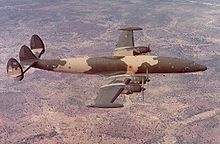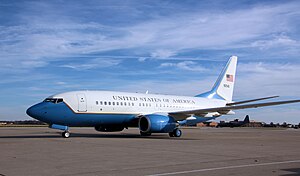|
54th Airlift Squadron
The 54th Airlift Squadron is a United States Air Force squadron stationed at Scott Air Force Base, Illinois. The squadron is an active duty associate unit aiding the 932d Airlift Wing in performance of its airlift mission. The first predecessor of the squadron was formed in August 1917 as the 54th Aero Squadron and served in France during World War II. In 1936, this unit was consolidated with the 54th School Squadron, a pilot training unit that became the 54th Bombardment Squadron, which became a demonstration unit for the Air Corps Tactical School, and later a test and evaluation unit for medium bomber aircraft and tactics. In 1985, this squadron was consolidated with the 54th Transport Squadron, an Air Transport Command unit that was involved with the movement of aircraft in the Caribbean during World War II, and the 554th Reconnaissance Squadron, which conducted surveillance of the Ho Chi Minh Trail during the Vietnam War. In 1993, the consolidated unit became the 54th Airlift Flight and has conducted operational support airlift since then. In 2005, the flight was expanded to squadron size. HistoryWorld War IThe first predecessor of the squadron was formed in August 1917 as the 54th Aero Squadron. The unit was organized primarily from recruits in the Columbus, Ohio area at Kelly Field, Texas. After a month of indoctrination training at Kelly, it moved to the Aviation Concentration Center at Hazelhurst Field, Long Island, New York, where it arrived on 21 September. At Hazelhurst, the squadron was outfitted for overseas duty, sailing on the Cunard Liner RMS Pannonia (1902) on 13 October with seven other squadrons, Arriving in Belfast, Ireland on the 28th. The following day, the squadron disembarked at Liverpool for a train trip to Southampton. The squadron arrived at Le Havre, France on 1 November.[4] After some rest in Le Havre, the squadron then boarded a French train for Issoudun Aerodrome in central France. Its mission was to assist in the construction of a large training aerodrome, designated the Third Aviation Instruction Center. The squadron erected wooden barracks, dug ditches for water and sewer lines as well as electricity and telephones. It was redesignated as the 466th Aero Squadron on 1 February 1918 when Aero Squadrons engaging in construction work were renumbered in the 400s.[4] On 10 March 1918, with the work largely completed at Issodun, the squadron was moved to Air Service Production Center No. 2 at Romorantin Aerodrome. There, the squadron assisted in the same type of construction it performed at Issodun.[4] By 1 April 1918, the facility was ready for use as an active Air Service training camp. As part of the permanent garrison at Romorantin, the squadron's mission was to assemble aircraft, work in the engineering department, maintain the facilitates of the base, operate the quartermaster's office and other administrative departments of the production center. It continued this work until the armistice in November 1918.[4] In late December 1918, the squadron was ordered to be demobilized by the Commanding General, Services of Supply, American Expeditionary Forces. It moved to a staging area near Brest where it awaited transportation back to the United States. The squadron arrived at Garden City, New York, at the end of January 1919 where it was demobilized and its men returned to civilian life.[3] Flying training The second predecessor of the 54th was the 54th School Squadron, which was activated in July 1927 at March Field, California. The squadron conducted flying training with Douglas BT-2s until July 1931, when the Air Corps concentrated its pilot training at fields in the San Antonio, Texas area and inactivated the squadron and March Field.[3] Air Corps Tactical SchoolThe squadron was activated again a little more than three months later at Maxwell Field, Alabama, where it was assigned to the Air Corps Tactical School. The squadron permitted students at the school to maintain flying proficiency while attending the school. In March 1935, the squadron was redesignated the 54th Bombardment Squadron. It was inactivated in September 1936. The following month, it was consolidated with the 466th Aero Squadron, although it remained in inactive status for the next three years.[3] Proving ground unit The squadron was reactivated at Maxwell in October 1939 and assigned to the 23d Composite Group. The group's mission was to demonstrate current tactics to students attending the Air Corps Tactical School, with the understanding that the group would also assume the demonstration and exhibition function that was being carried out by combat units of Air Force Combat Command. The group was also assigned the mission of performing tactical service tests of aircraft and other equipment; developing and testing new air tactics; and demonstrating these new tactics to the service schools of the other branches of the United States Army, to General Headquarters, and at Air Corps stations.[5] The squadron was initially the group's bomber unit, although two months after it was activated, it added "Medium" to its designation when the 24th Attack-Bombardment Squadron was added to the 23d Group as its attack and dive bomber unit.[1][6] The squadron moved to Orlando Army Air Base, Florida the following year, and to Eglin Field on 1 July 1941. When the Japanese attacked Pearl Harbor, the squadron was equipped with various aircraft types at Eglin. The squadron's mission focused on developing and demonstrating tactics and doctrine. After moving to Eglin it also conducted testing of experimental weapons, including the Martin B-26 Marauder. On 1 May 1942, the squadron and the group's other squadrons were disbanded[1] as the group focused on weapons development rather than tactics. Ferrying and airliftThe third predecessor of the squadron was organized at Homestead Army Air Base, Florida in September 1942 as the 54th Ferrying Squadron. For the next year, the squadron, later redesignated the 54th Transport Squadron, ferried aircraft from Florida to various locations in the Caribbean. In the fall of 1943, Air Transport Command reorganized its operations at Homestead, replacing its overseas ferrying squadrons there with Station 8, Caribbean Wing, Air Transport Command and the squadron was disbanded on 7 November.[1] Reconnaissance in Southeast Asia The last predecessor of the squadron is the 554th Reconnaissance Squadron, which was activated at Otis Air Force Base, Massachusetts in February 1957. At Otis it began to train with Lockheed C-121G Constellations as it equipped with Lockheed EC-121R Batcats. Once training was completed, the squadron moved to Korat Royal Thai Air Force Base, Thailand to begin operations monitoring movement on the Ho Chi Minh Trail in Laos.[1] The squadron's planes monitored information provided by sensors on the ground that had been delivered by other aircraft or special forces. These included Air Delivered Seismic Intrusion Detectors, which picked up vibrations in the earth caused by vehicle traffic and transmitted them to the aircraft. Sequential transmissions by these sensors permitted analysis of vehicle speed and route. These were combined with sound detectors that helped determine what type of vehicle was operating.[7] The sensor information was retransmitted by the squadron's aircraft to the infiltration surveillance center located at Nakhon Phanom Royal Thai Air Force Base (NKP) for Analysis.[8] In October 1970, the squadron replaced its C-121s with the smaller Beechcraft QU-22. In December 1970, the squadron's parent 553d Reconnaissance Wing was inactivated and the squadron moved on paper to NKP, where it took over the operations of what had been Detachment 1 of the 553d Wing at NKP and was assigned to the 56th Special Operations Wing. The squadron inactivated at the end of September 1972.[1] In September 1985, the 554th was consolidated with the 54th Bombardment Squadron and the 54th Transport Squadron as the 554th Tactical Intelligence Squadron. However, the consolidated squadron was never active under that name.[1] Return to airlift mission The squadron was never active as an intelligence unit, but was redesignated the 54th Airlift Flight and returned to Maxwell Air Force Base, on 1 April 1993. It provided airlift for senior officers and others stationed at Maxwell. In April 1997, Air Mobility Command centralized management of this type of airlift under the 375th Air Mobility Wing. As a result of this reorganization, the flight moved to Wright-Patterson Air Force Base, Ohio, where it remained until 2004. In September of that year, the 54th moved to Scott Air Force Base, Illinois and became a squadron once again as the 54th Airlift Squadron. It inactivated at Scott on the last day of 2006. The squadron was again activated in March 2007 at Scott. The squadron operates as a Total Force Associate unit aiding the 932d Airlift Wing mission. The 54th belongs administratively to the 375th Operations Group at Scott. However, it operates under the 932d Operations Group alongside the reserve 73d Airlift Squadron. With this relationship the 73d Airlift Squadron owns the aircraft, and the 54th Airlift Squadron provides aircrew members flying together as one mixed crew. The primary aircraft currently operated is the Boeing C-40 Clipper. The primary mission of the 54th Airlift Squadron is safe, comfortable, and reliable transportation of our nation's senior leaders.[9] Lineage
Assignments
Stations
Aircraft
ReferencesNotes
Bibliography
External links
|
||||||||||||||||||||||||||||||||||||




